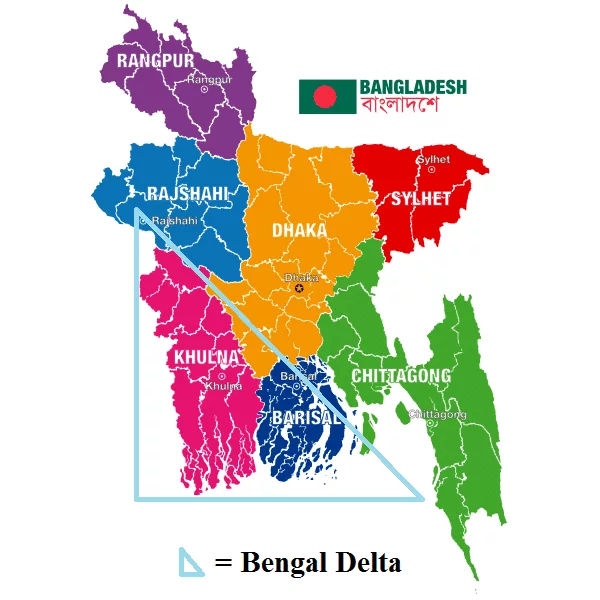Bengal delta or Ganges delta
The Bengal delta or Ganges delta is the world’s largest river delta which is located in Southeast Asia with a coastline of about 580 km on the Bay of Bengal. This delta occupies about 79% of Bangladesh which is a low-laying, agriculture-based, and also a densely-populated country. During the monsoon period the mighty rivers Ganges, Brahmaputra, and Meghna flow at 140,000 cubic meters per second which is very important for our annual agricultural production but also one of the main causes of riverbank erosion.

In Bangladesh mainly June to mid-October is considered as the rainy season and 75-80%of the country’s annual rainfall occurs at this time. During this season the volume of water often exceeds the carrying capacity of the mighty rivers and occurs flood and bank erosion. This overflowing of water causes massive riverbank erosion. Not only that the dynamic character of these rivers is also a major cause of bank erosion. This erosion destroys standing crops, farmland, household land, schools, hospital, etc. It is estimated that about 5% of the total floodplain of Bangladesh is directly affected by erosion.
Only riverbank erosion is not a concern for this country. Nowadays global warming is a big phenomenon all over the world and as a low-lying coastal country, Bangladesh is in great danger of this phenomenon. According to IPCC(Inter-governmental Panel for Climatic Change), a sea-level rise up to 50cm is expected by 2100 A.D. when a great part of the Maldives, Egypt, and Bangladesh would be submerged and wiped out of the world map. So it is a great concern for Bangladesh that after 2 or 3 generations a huge portion of this country may go underwater.
When all over the world is greatly concerned about rising sea level and about 1 million people are affecting for riverbank erosion every year in Bangladesh, then some scientists have shown a light of hope. At the mouth of the mighty rivers and Bay of Bengal, there are growing some new islands. The sediments taken by the rivers create these islands. Last 2 or 3 years we found about 20 new islands. Some years ago these lands used to submerse at the tidal water, but now they have become permanent and they are increasing day by day. Hopefully, 40-50 sunken islands are still growing here which will be permanent within 5-7 years. The southern region of Bangladesh is very important for biodiversity because there is the world’s largest mangrove forest, Sundarban. After surveying some satellite images of coastal areas of Bangladesh, the scientists of the Center for Environment and Geographic Information Services (SEGIS) currently informed that the area of this country is increasing about 20sq km per year due to these new islands.
The islands are increasing rapidly and our environmental workers are working much to make the islands permanent. Salt tolerant plants are planted there to make the lands strong. This forest is not only a shelter for the creatures but also protects the coastal region from tsunami, cyclone, and tidal wave that hit on the coast of Bay of Bengal. The Sundarban is also very important for the habitat of Royal Bengal Tiger. So it is urgent to make the lands permanent and enlarge the largest mangrove forest. Besides this, we also can give shelter to those people who lost their lands due to riverbank erosion.
Already our scientists have given their attention to this sector. In their opinion Cross dam is an effective process to add the lands with our mainland. When all over the world is concerned about global warming, it’ll be great news for us if we can protect the lands immediately. The areas of the new lands are not negligible. Here land gain is higher than land loss. So maybe within 20 years, we are going to have some new lands, which will be about half of the present total land area of Bangladesh. But only it will be possible with proper care and the help of technology.
Reference:
Sifatul Quader Chowdhury- Riverbank Erosion, e.banglapedia.org; Steve Connor-The Independent, London(Aug 2005); Saidur Rahman Rimon- Another Bangladesh has awakened in the Bay of Bengal.
Author:
Pragga Paromita Das
Dept. of Soil and Environmental Sciences,
The University of Barishal, Bangladesh